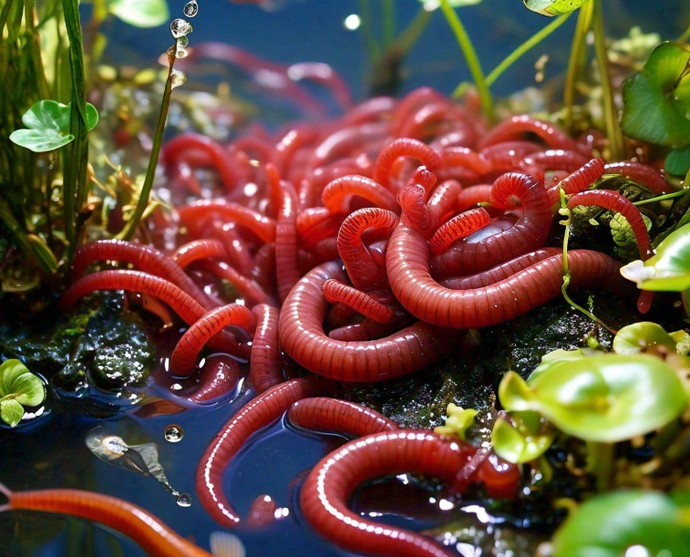Red worms: Best for composting
Red worms: Best for composting
Blog Article
Making Use Of Red Wigglers for Reliable Organic Waste Disposal
Using red wigglers for organic garbage disposal offers a compelling approach to managing food scraps while advertising ecological sustainability. These worms not just improve waste decomposition but additionally generate beneficial worm spreadings, which can dramatically enhance soil health. Their capacity to refine huge quantities of organic material with very little effort positions them as an easily accessible remedy for homes and neighborhoods alike. Nevertheless, understanding the subtleties of setting up a successful worm container and keeping an optimum environment is crucial for maximizing their benefits. The next action in this procedure may amaze you.
Advantages of Utilizing Red Wigglers
One of one of the most engaging advantages of making use of red wigglers for organic waste disposal is their impressive effectiveness in composting. These worms, clinically referred to as Eisenia fetida, are particularly adjusted for breaking down organic materials, allowing them to process waste up to two times their body weight every day. This quick decay not only increases the composting process yet likewise produces nutrient-rich worm castings that significantly improve soil top quality.
Additionally, red wigglers add to a reduction in land fill waste. By diverting organic products from land fills, they aid decrease methane emissions-- a powerful greenhouse gas. This environmental advantage is crucial in the fight versus climate adjustment.
In addition, red wigglers are low-maintenance and can thrive in different environments, making them available for both beginner and seasoned composters. Their ability to reproduce promptly ensures a steady populace, helping with continuous waste processing.
Establishing Your Worm Bin
Producing a reliable worm container is crucial for making the most of the benefits of composting with red wigglers. Make certain the container has adequate drainage holes to prevent excess wetness, as red wigglers prosper in a wet but not soggy atmosphere.
(red wiggler fishing worms)Next, prepare the bed linens product, which serves as the worms' environment and food source. The bin should be positioned in a dark, temperature-controlled area, preferably between 55 ° F and 77 ° F, to preserve worm activity.
Once the bin is established up, introduce the red wigglers, permitting them to adapt to their new setting. A properly maintained bin will not only sustain the health of the worms yet also promote efficient decay of organic waste.
(Raleigh Worm Farms)
What to Feed Red Wigglers
An understanding of the proper diet plan for red wigglers is important for maintaining a healthy worm populace and enhancing composting effectiveness. These items not only give crucial nutrients yet likewise contribute to the dampness equilibrium within the worm bin.
It is essential to stay clear of particular foods that can hurt the worm population. Red wigglers need to not be fed meat, milk products, oily foods, or refined products, as these can attract pests and develop unpleasant smells. red wigglers. Furthermore, citrus fruits and spicy foods need to be have a peek at this site lessened, as their acidity can be detrimental to worms
To advertise optimal food digestion, food must be chopped right into smaller items, assisting in quicker break down and intake. Introducing food in small amounts is likewise vital; overfeeding can cause anaerobic conditions and draw in undesirable bugs. Monitoring the worm container for food consumption prices will certainly assist ensure that red wigglers are getting an adequate diet plan while maintaining an effective composting setting. Proper feeding techniques are important for cultivating a flourishing ecological community within the worm bin.
Keeping Your Worm Habitat
A well-kept worm habitat is necessary for the wellness and efficiency of red wigglers. To make certain optimal problems, it is crucial to keep track of temperature level, dampness, and aeration within the worm container (red wigglers).
An excellent regulation of thumb is to preserve wetness at approximately 70% to 80%. If the bed linens comes to be as well wet, it can lead to anaerobic problems that are dangerous to the worms.

Utilizing Worm Spreadings in Horticulture
Rich in nutrients and valuable bacteria, worm castings act as an exceptional natural plant food for gardening. Created via the digestive processes of red wigglers, these castings contain an array of necessary nutrients, including nitrogen, phosphorus, and potassium, which promote durable plant growth. Unlike artificial fertilizers, worm spreadings use a slow-release system, guaranteeing that nutrients are offered to plants over an extended period, therefore lowering the risk of nutrient leaching and soil depletion.
Along with nutrient web content, worm castings enhance dirt structure and oygenation, enhancing wetness retention and drainage. The microbial life existing in worm castings aids to reduce pathogens and advertises a healthy dirt community, further profiting plant health. When included into the dirt or utilized as a leading dressing, worm spreadings can substantially increase seed germination prices, root growth, and overall plant vitality.
For optimal outcomes, gardeners must apply worm spreadings at a rate of 1-2 inches per square foot, mixing them into the soil or including them into potting blends. Overall, utilizing worm spreadings is an environment-friendly approach to enhancing dirt fertility and guaranteeing growing garden atmospheres.
Verdict

Report this page